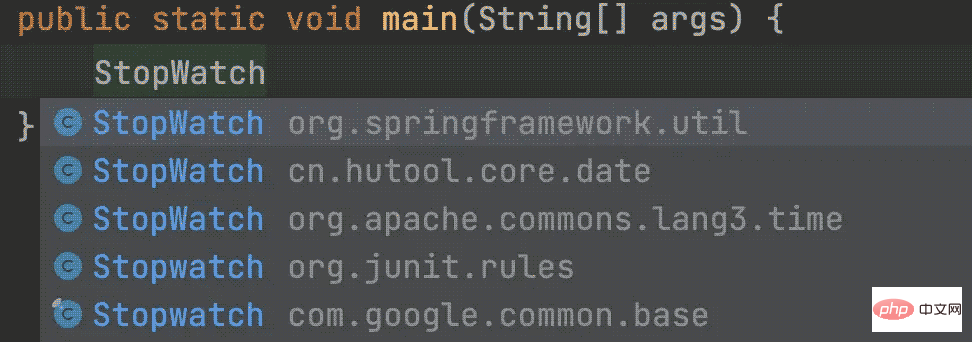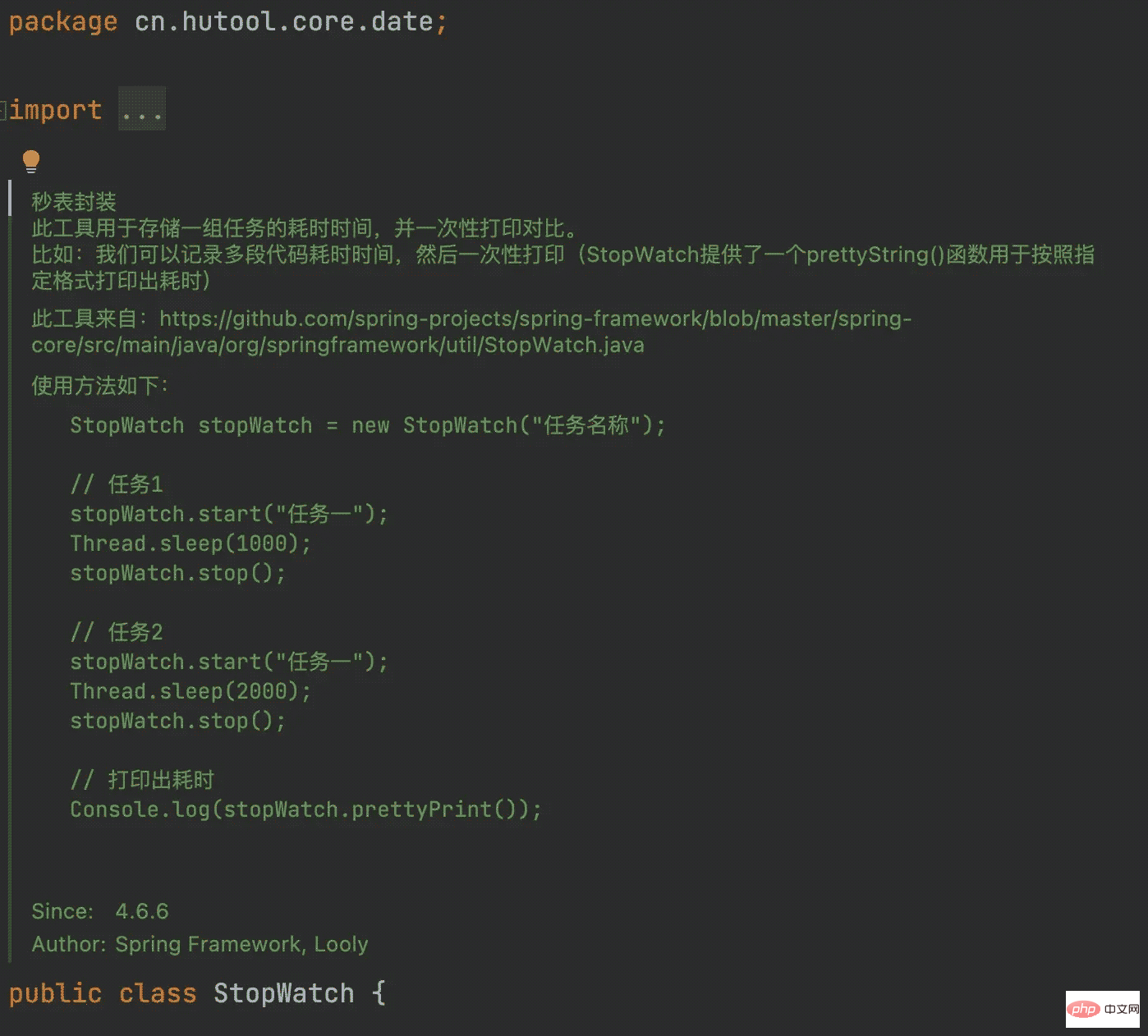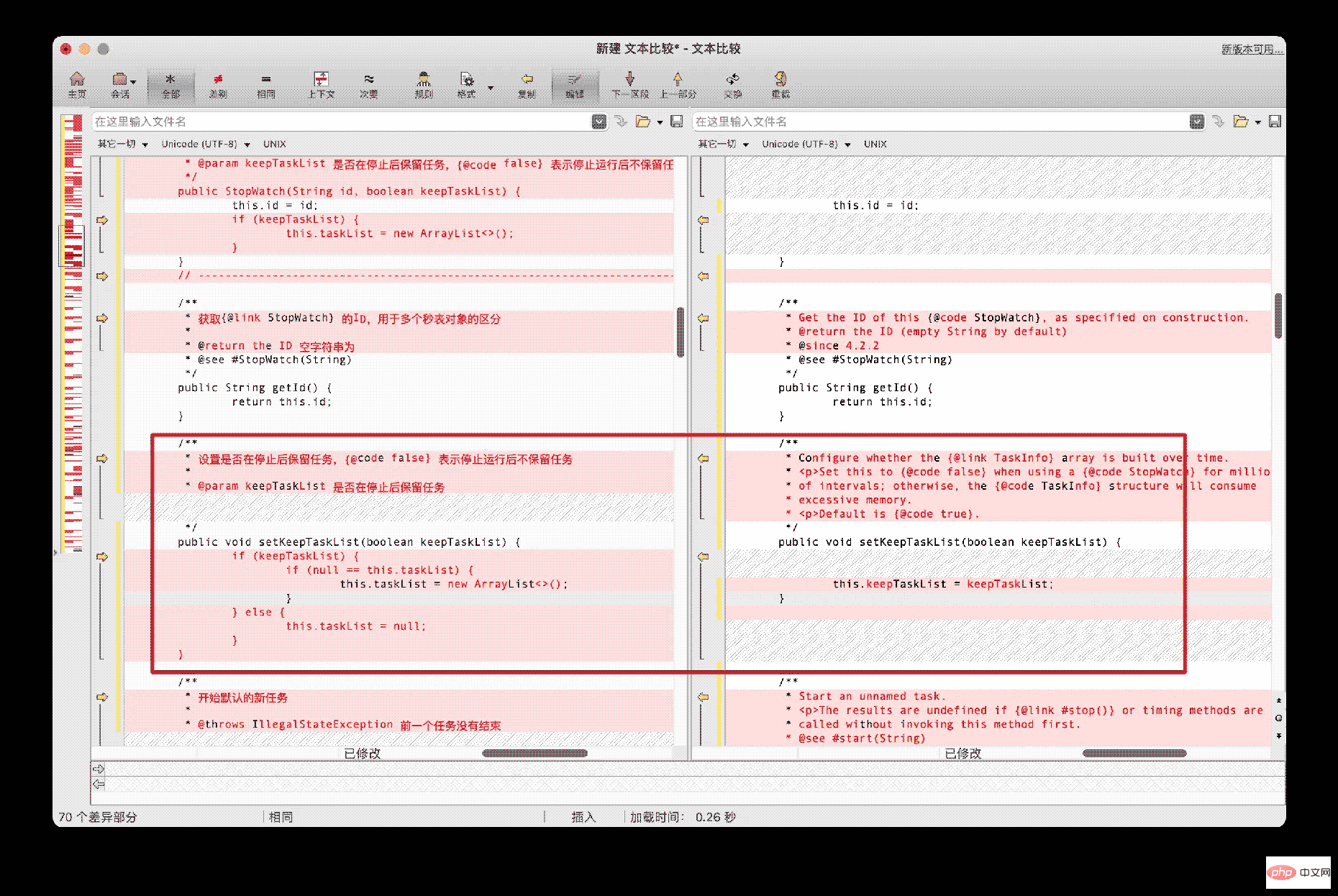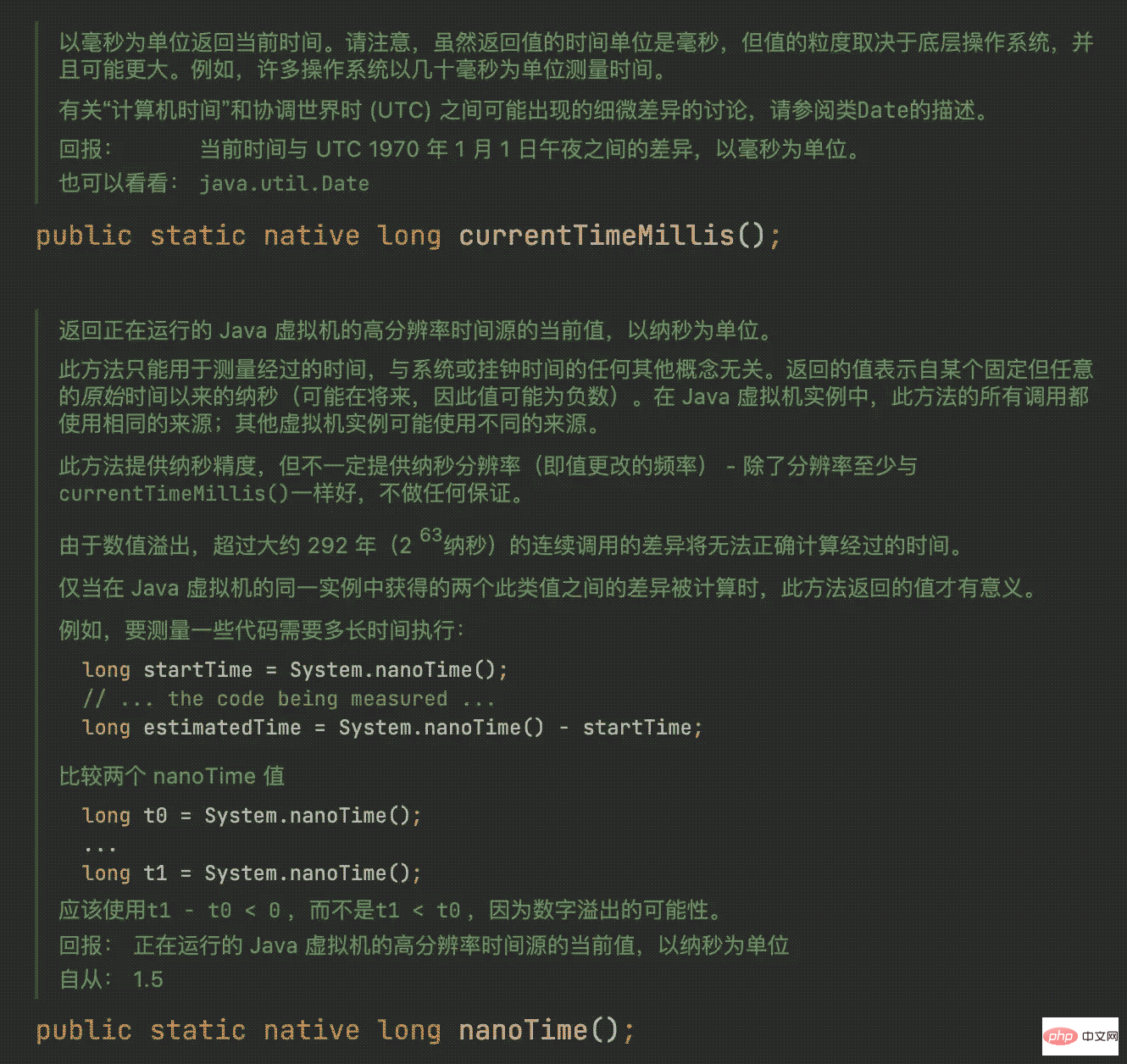 Java
Java
 javaTutorial
javaTutorial
 How Spring Boot source code implements StopWatch to elegantly count time consumption
How Spring Boot source code implements StopWatch to elegantly count time consumption
How Spring Boot source code implements StopWatch to elegantly count time consumption
Introduction
Yesterday, a golfer asked me if I could explain to him what the @SpringBootApplication annotation means and how Spring Boot operates, so I took him to pick up this annotation. The source code, as well as the source code of the run() method of the SpringApplication class, he understood it at once.
Don’t tell me, the process of looking at the source code is really interesting. No, I discovered an interesting point.
public ConfigurableApplicationContext run(String... args) {
StopWatch stopWatch = new StopWatch();
stopWatch.start();
......
stopWatch.stop();
}Spring Boot uses StopWatch to count time consumption, and usually, we use System.currentTimeMillis() to count time consumption, right? Programming Meow???? There is such a piece of code in the open source project, when dealing with unified log processing aspects.
@Around("webLog()")
public Object doAround(ProceedingJoinPoint joinPoint) throws Throwable {
long startTime = System.currentTimeMillis();
long endTime = System.currentTimeMillis();
webLog.setSpendTime((int) (endTime - startTime));
}In comparison, we can find that System.currentTimeMillis() provided by JDK is not as concise and clear as StopWatch provided by Spring.
StopWatch usage
Especially when multi-tasking, StopWatch is so easy to use????!
// 创建一个 StopWatch 实例
StopWatch sw = new StopWatch("沉默王二是傻 X");
// 开始计时
sw.start("任务1");
Thread.sleep(1000);
// 停止计时
sw.stop();
System.out.printf("任务1耗时:%d%s.\n", sw.getLastTaskTimeMillis(), "ms");
sw.start("任务2");
Thread.sleep(1100);
sw.stop();
System.out.printf("任务2耗时:%d%s.\n", sw.getLastTaskTimeMillis(), "ms");
System.out.printf("任务数量:%s,总耗时:%ss.\n", sw.getTaskCount(), sw.getTotalTimeSeconds());See, is it very simple?
First create a new StopWatch object
Then start to start timing
Then stop to stop timing
Finally get the time difference through sw.getLastTaskTimeMillis()
If you change it to System.currentTimeMillis(), you will die. You must declare it first There are several long-type local variables, and then the second one is subtracted from the first one, and the third one is subtracted from the second one. If you are a little careless (especially the CV method), it is easy to make mistakes.
In addition to the local time, you can also get the total time through sw.getTotalTimeSeconds().
Task 1 takes 1002ms.
Task 2 takes 1105ms.
Number of tasks: 2, total time: 2.107820109s.
In addition, StopWatch also provides a sw.prettyPrint() method to print out beautifully formatted results:
StopWatch 'Silent Wang Er is stupid': running time = 2108529351 ns
- --------------------------------------------------
ns % Task name
------------------------------------------------
1004338467 048% Task 1
1104190884 052% Task 2
has the time taken, the occupied percentage, and the task name, which is very clear.
In addition to Spring, the hutool tool library and the Apache common tool package provide their own StopWatch.

Looking at the StopWatch source code in the hutool tool library, we can see that this class actually comes from Spring's StopWatch.java, and its usage is exactly the same.

This shows that the author of hutool also thinks that Spring’s StopWatch is well written, hahaha????.
Use Beyond compare to compare
Using Beyond compare to compare, we can also find that except for one Chinese comment and one English comment, the codes are almost the same. The setKeepTaskList method is quite different.

That is to say, if you do not use Spring Family Bucket in your project and only use the hutool tool package, you can use hutool's StopWatch instead of System.currentTimeMillis ().
By analyzing the stop method source code of StopWatch:
public void stop() throws IllegalStateException {
if (null == this.currentTaskName) {
throw new IllegalStateException("Can't stop StopWatch: it's not running");
}
final long lastTime = System.nanoTime() - this.startTimeNanos;
this.totalTimeNanos += lastTime;
this.lastTaskInfo = new TaskInfo(this.currentTaskName, lastTime);
if (null != this.taskList) {
this.taskList.add(this.lastTaskInfo);
}
++this.taskCount;
this.currentTaskName = null;
}In fact, we can find that StopWatch is timed internally through System.nanoTime(), which is essentially the same as System.currentTimeMillis(). big.
nanoTime is more granular than currentTimeMillis. The former is in nanoseconds and the latter is in milliseconds.

#Note that both are native methods, that is to say, the granularity of the value actually depends on the underlying operating system.
After seeing this, everyone may suddenly realize that StopWatch is just System.currentTimeMillis() in a coat?
But the wonderful thing is that this coat is beautiful enough and elegant enough. StopWatch can record the name of each subtask and print the results in a format, which is more friendly especially for multi-task statistics.
Of course, in addition to choosing StopWatch of Spring and hutool, StopWatch of Apache commons-lang3 is also a good option, which is more flexible and changeable.
StopWatch sw = StopWatch.createStarted();
Thread.sleep(1000);
System.out.printf("耗时:%dms.\n", sw.getTime());The other two create StopWatch objects through new, and commons-lang3 can also be completed through createStarted (create and start immediately) and create (create).
You can also call the suspend method to pause the timing, the resume method to resume the timing, and the reset method to restart the timing.
// 暂停计时
sw.suspend();
System.out.printf("暂停耗时:%dms.\n", sw.getTime());
// 恢复计时
sw.resume();
System.out.printf("恢复耗时:%dms.\n", sw.getTime());
// 停止计时
sw.stop();
System.out.printf("总耗时:%dms.\n", sw.getTime());
// 重置计时
sw.reset();
// 开始计时
sw.start();
System.out.printf("重置耗时:%dms.\n", sw.getTime());The above is the detailed content of How Spring Boot source code implements StopWatch to elegantly count time consumption. For more information, please follow other related articles on the PHP Chinese website!

Hot AI Tools

Undresser.AI Undress
AI-powered app for creating realistic nude photos

AI Clothes Remover
Online AI tool for removing clothes from photos.

Undress AI Tool
Undress images for free

Clothoff.io
AI clothes remover

Video Face Swap
Swap faces in any video effortlessly with our completely free AI face swap tool!

Hot Article

Hot Tools

Notepad++7.3.1
Easy-to-use and free code editor

SublimeText3 Chinese version
Chinese version, very easy to use

Zend Studio 13.0.1
Powerful PHP integrated development environment

Dreamweaver CS6
Visual web development tools

SublimeText3 Mac version
God-level code editing software (SublimeText3)

Hot Topics
 1393
1393
 52
52
 1207
1207
 24
24
 How Springboot integrates Jasypt to implement configuration file encryption
Jun 01, 2023 am 08:55 AM
How Springboot integrates Jasypt to implement configuration file encryption
Jun 01, 2023 am 08:55 AM
Introduction to Jasypt Jasypt is a java library that allows a developer to add basic encryption functionality to his/her project with minimal effort and does not require a deep understanding of how encryption works. High security for one-way and two-way encryption. , standards-based encryption technology. Encrypt passwords, text, numbers, binaries... Suitable for integration into Spring-based applications, open API, for use with any JCE provider... Add the following dependency: com.github.ulisesbocchiojasypt-spring-boot-starter2. 1.1Jasypt benefits protect our system security. Even if the code is leaked, the data source can be guaranteed.
 How SpringBoot integrates Redisson to implement delay queue
May 30, 2023 pm 02:40 PM
How SpringBoot integrates Redisson to implement delay queue
May 30, 2023 pm 02:40 PM
Usage scenario 1. The order was placed successfully but the payment was not made within 30 minutes. The payment timed out and the order was automatically canceled. 2. The order was signed and no evaluation was conducted for 7 days after signing. If the order times out and is not evaluated, the system defaults to a positive rating. 3. The order is placed successfully. If the merchant does not receive the order for 5 minutes, the order is cancelled. 4. The delivery times out, and push SMS reminder... For scenarios with long delays and low real-time performance, we can Use task scheduling to perform regular polling processing. For example: xxl-job Today we will pick
 How to use Redis to implement distributed locks in SpringBoot
Jun 03, 2023 am 08:16 AM
How to use Redis to implement distributed locks in SpringBoot
Jun 03, 2023 am 08:16 AM
1. Redis implements distributed lock principle and why distributed locks are needed. Before talking about distributed locks, it is necessary to explain why distributed locks are needed. The opposite of distributed locks is stand-alone locks. When we write multi-threaded programs, we avoid data problems caused by operating a shared variable at the same time. We usually use a lock to mutually exclude the shared variables to ensure the correctness of the shared variables. Its scope of use is in the same process. If there are multiple processes that need to operate a shared resource at the same time, how can they be mutually exclusive? Today's business applications are usually microservice architecture, which also means that one application will deploy multiple processes. If multiple processes need to modify the same row of records in MySQL, in order to avoid dirty data caused by out-of-order operations, distribution needs to be introduced at this time. The style is locked. Want to achieve points
 How to solve the problem that springboot cannot access the file after reading it into a jar package
Jun 03, 2023 pm 04:38 PM
How to solve the problem that springboot cannot access the file after reading it into a jar package
Jun 03, 2023 pm 04:38 PM
Springboot reads the file, but cannot access the latest development after packaging it into a jar package. There is a situation where springboot cannot read the file after packaging it into a jar package. The reason is that after packaging, the virtual path of the file is invalid and can only be accessed through the stream. Read. The file is under resources publicvoidtest(){Listnames=newArrayList();InputStreamReaderread=null;try{ClassPathResourceresource=newClassPathResource("name.txt");Input
 How to implement Springboot+Mybatis-plus without using SQL statements to add multiple tables
Jun 02, 2023 am 11:07 AM
How to implement Springboot+Mybatis-plus without using SQL statements to add multiple tables
Jun 02, 2023 am 11:07 AM
When Springboot+Mybatis-plus does not use SQL statements to perform multi-table adding operations, the problems I encountered are decomposed by simulating thinking in the test environment: Create a BrandDTO object with parameters to simulate passing parameters to the background. We all know that it is extremely difficult to perform multi-table operations in Mybatis-plus. If you do not use tools such as Mybatis-plus-join, you can only configure the corresponding Mapper.xml file and configure The smelly and long ResultMap, and then write the corresponding sql statement. Although this method seems cumbersome, it is highly flexible and allows us to
 Comparison and difference analysis between SpringBoot and SpringMVC
Dec 29, 2023 am 11:02 AM
Comparison and difference analysis between SpringBoot and SpringMVC
Dec 29, 2023 am 11:02 AM
SpringBoot and SpringMVC are both commonly used frameworks in Java development, but there are some obvious differences between them. This article will explore the features and uses of these two frameworks and compare their differences. First, let's learn about SpringBoot. SpringBoot was developed by the Pivotal team to simplify the creation and deployment of applications based on the Spring framework. It provides a fast, lightweight way to build stand-alone, executable
 How SpringBoot customizes Redis to implement cache serialization
Jun 03, 2023 am 11:32 AM
How SpringBoot customizes Redis to implement cache serialization
Jun 03, 2023 am 11:32 AM
1. Customize RedisTemplate1.1, RedisAPI default serialization mechanism. The API-based Redis cache implementation uses the RedisTemplate template for data caching operations. Here, open the RedisTemplate class and view the source code information of the class. publicclassRedisTemplateextendsRedisAccessorimplementsRedisOperations, BeanClassLoaderAware{//Declare key, Various serialization methods of value, the initial value is empty @NullableprivateRedisSe
 How to get the value in application.yml in springboot
Jun 03, 2023 pm 06:43 PM
How to get the value in application.yml in springboot
Jun 03, 2023 pm 06:43 PM
In projects, some configuration information is often needed. This information may have different configurations in the test environment and the production environment, and may need to be modified later based on actual business conditions. We cannot hard-code these configurations in the code. It is best to write them in the configuration file. For example, you can write this information in the application.yml file. So, how to get or use this address in the code? There are 2 methods. Method 1: We can get the value corresponding to the key in the configuration file (application.yml) through the ${key} annotated with @Value. This method is suitable for situations where there are relatively few microservices. Method 2: In actual projects, When business is complicated, logic



